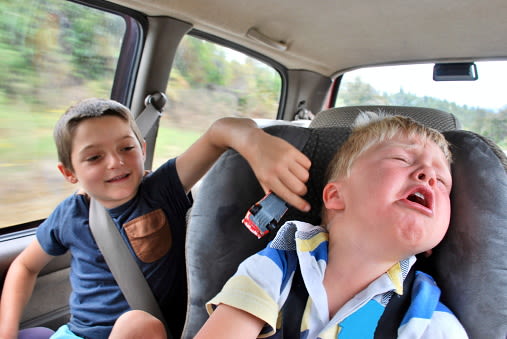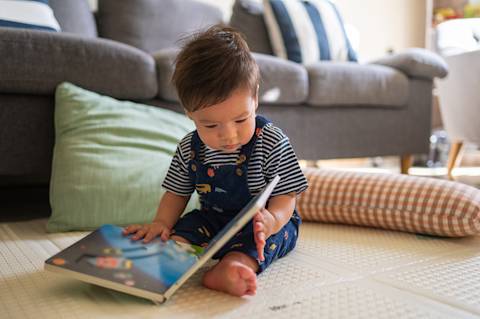Raising siblings can be a roller-coaster ride. One moment, they might be playing peacefully, sharing toys and giggles. And then the next moment, a fight breaks out. Sibling conflicts and disagreements are common, but they can be challenging to manage and resolve. We’ve provided some techniques that caregivers can try to help reduce sibling conflicts and promote a peaceful home environment—while teaching valuable skills that will benefit them throughout their lives.

Set clear expectations: Establishing clear boundaries and expectations can include rules about respecting each other's personal space, using kind language, and avoiding physical aggression. When setting expectations, explaining what will happen if the child doesn’t meet your expectations is important. The consequence should be clear and connected to the boundary that they crossed. It’s crucial to follow through on the consequence each time the expectation is unmet. For example, you can say:
“In our family, we treat each other with kindness and respect. Fighting is not allowed. If you fight with your sibling, you both will need to have quiet time alone until you can use your words.”
“If you have a disagreement with your sibling, it’s important to find a way to work it out using our words. We love our siblings and we don’t want to hurt them. You can always ask for help from an adult if needed. If you can’t use your words to solve the problem, then we’ll have to take a break from playing until you can use your words.”
“It’s very important to be kind. Part of being kind is sharing our toys. If you cannot share your toys with your sibling, then neither of you can play with the toy until you learn how to share.”
Use positive reinforcement: Praise and reward your children when they show positive behaviors, such as playing together peacefully or resolving a conflict without fighting. For example, you can say:
“I noticed that you two are playing well together and sharing your toys. I’m really proud of both of you!”
“It's great to see you taking turns with the game and treating each other kindly. Keep up the good work!”
“I love how you're listening to your sibling’s ideas and trying new things together. That shows how caring you can be.”
“Thank you for including your brother/sister in your playtime. It makes me happy to see you two getting along so well.”
“I noticed you helped your sibling when they were struggling with their puzzle. That was very thoughtful and kind of you.”
Offer individual attention and avoid comparisons: Spend one-on-one time with each of your children to help them feel valued and loved. This can reduce their need to compete with each other for attention. Check out some activities you can do with each of your children to spend quality time together. Additionally, do your best to avoid comparing your children to each other, as this can create feelings of resentment and competition. For example, try your best to avoid language like, “Your brother always cleans his room; why can’t you?” or “Why can’t you be quiet like your sister?”
Provide personal space: Providing personal space can include assigning specific corners of the main living area to each child so they have an area they can go to when they’re feeling overwhelmed or need some alone time. Some caregivers use room dividers, curtains, screens, or blankets to create an even more private area for older children. Other families position their furniture—like couches—to help create a more private area. This gives them a space that’s all their own where they can find calm when feeling big emotions.
Create opportunities for cooperation: Encourage your children to work together on tasks and projects, such as cleaning up their toys or planning a family outing. This can promote teamwork and reduce conflicts.
Remove children from potential harm: If your children are physically fighting, the first step is ensuring everyone is safe. Tell the children to take five steps away from each other. If they don’t, explain that you’ll have to separate them physically. Wrap one child up in a big, firm hug and take them to their personal space while explaining exactly what you’re doing and why. For example, you can say:
“I see that both of you are very upset right now. Go to your personal space and take a few minutes to cool down. If you can’t go on your own, I will carry you there because I want you to be safe. It’s your choice how you want to go to your space.”
“Fighting is not the answer, and we need to find a more peaceful way to solve this problem. Let’s separate for a short time to think about how we can solve this issue without hurting each other. I will take you to your space if you won’t go on your own.”
“I understand that you're both feeling angry, but we can’t solve anything when we’re this upset. Go to your rooms for a little while to calm down, and then we'll talk about what happened.”
Listen and validate feelings: Once your children are in a safe space, take the time to listen to both sides of the story and validate their feelings. This helps them feel heard and understood, which can reduce their need to fight. For example, you can say:
“I can see that you’re feeling [sad, frustrated, angry]. It’s okay to feel this way.”
“It sounds like you’re upset because [describe the situation in simple terms]. That would make me feel [emotion] too.”
“It’s normal to have strong feelings when things don’t go as expected or when things change. When we’re feeling big feelings, we can take some deep breaths or talk to an adult.”
“Your feelings matter, and it’s good that you’re expressing them. Let’s figure out what we can do to help you feel better.”
“Remember, all feelings are okay—it’s what we do with them that matters. We can talk or find an activity that helps you calm down and process your emotions.”
Remind them about expectations and consequences: When your children act out, it’s important to remind them about the expectations that you set ahead of time and follow through on the consequences. When consequences are consistently carried out, children learn to anticipate the outcomes of their actions, which helps them develop self-discipline and decision-making skills, as well as learn that they are responsible for their actions. For example, you can say:
“Fighting is not allowed in our family. Because you both were fighting, you’ll need to take a break for a few minutes to calm down and think about your actions.”
“Since you were fighting over the toy, neither of you can play with it for the next 30 minutes. This is a reminder that we need to share and treat each other with kindness.”
“I understand that you’re upset, but remember our family rule: We use our words, not our hands. You’ll need to spend some time in your space to think about how you can handle the situation better next time.”
“Remember, we don’t hit or yell at others when angry or frustrated. Next time, let’s try talking to each other instead. For now, it’s time to take a break and think about a better way to handle the situation.”
Teach conflict resolution skills: Help your children learn how to resolve conflicts peacefully by teaching good communication and problem-solving skills. Encourage them to express their feelings calmly and respectfully and to work together to find a solution. For example, you can say:
“Can you tell me what happened? Use your words to explain how you’re feeling and what the problem is.”
“Now, let’s think of ways to solve this problem together. What are some ideas you have?”
“Let’s try to take turns and share. This way, both of you can enjoy playing with the toy.”
“It’s important to apologize when we hurt someone’s feelings. You can say, ‘I’m sorry for making you feel sad. Can we play together again?’”
When siblings constantly fight, it’s exhausting for caregivers to continually play referee. By trying these strategies, you can help minimize conflicts, and your children can learn valuable skills in communication and cooperation.






